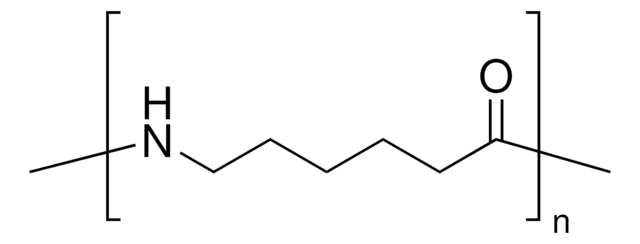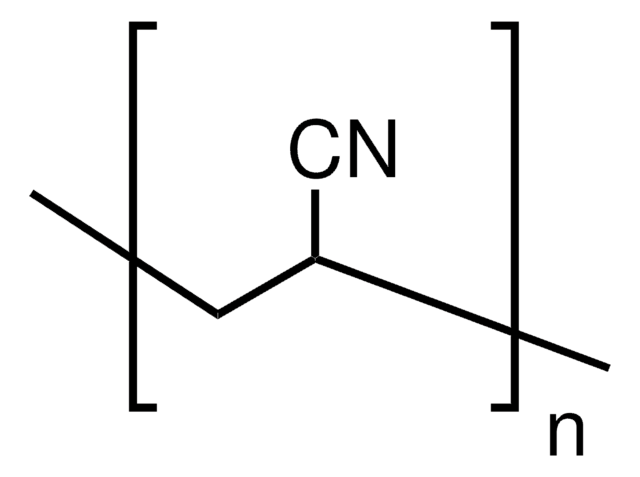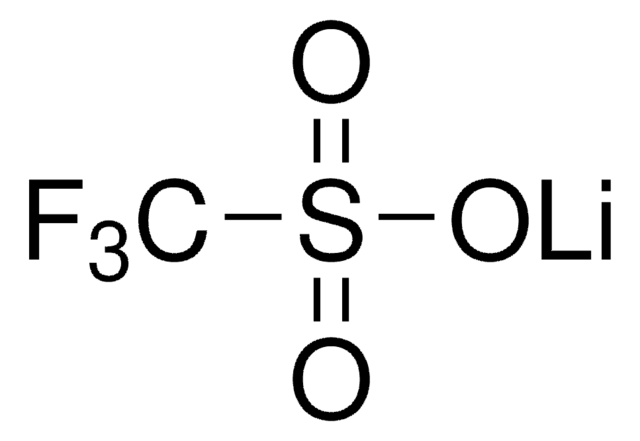Key Documents
182028
Poly(ethylene oxide)
average MV 600,000 (nominal), powder, hydroxyl, BHT as inhibitor
Synonim(y):
Polyethylene oxide, PEO
About This Item
Polecane produkty
product name
Poly(ethylene oxide), average Mv 600,000 (nominal), powder
Postać
powder
Poziom jakości
masa cząsteczkowa
average Mv 600,000 (nominal)
zawiera
200-500 ppm BHT as inhibitor
lepkość
4,500-8,800 cP, 5 % in H2O(25 °C, Brookfield)(lit.)
temp. przejścia
Tm 65 °C
Ω-koniec
hydroxyl
α-koniec
hydroxyl
Zastosowanie
battery manufacturing
ciąg SMILES
[H]OCCO
InChI
1S/C2H6O2/c3-1-2-4/h3-4H,1-2H2
Klucz InChI
LYCAIKOWRPUZTN-UHFFFAOYSA-N
Szukasz podobnych produktów? Odwiedź Przewodnik dotyczący porównywania produktów
Opis ogólny
Zastosowanie
- Bioabsorbable and injectable hydrogels for sustained drug release.
- PEO/graphene oxide composite electrolyte membrane for fuel cells.
- Poly(ethylene oxide)-b-poly(ε-caprolactone) (PEO-b-PCL) diblock copolymer. Losartan potassium encapsulated (PEO-b-PCL) copolymer can be used as a drug carrier.
Kod klasy składowania
11 - Combustible Solids
Klasa zagrożenia wodnego (WGK)
WGK 1
Temperatura zapłonu (°F)
Not applicable
Temperatura zapłonu (°C)
Not applicable
Środki ochrony indywidualnej
Eyeshields, Gloves, type N95 (US)
Wybierz jedną z najnowszych wersji:
Masz już ten produkt?
Dokumenty związane z niedawno zakupionymi produktami zostały zamieszczone w Bibliotece dokumentów.
Klienci oglądali również te produkty
Produkty
Progress in biotechnology fields such as tissue engineering and drug delivery is accompanied by an increasing demand for diverse functional biomaterials. One class of biomaterials that has been the subject of intense research interest is hydrogels, because they closely mimic the natural environment of cells, both chemically and physically and therefore can be used as support to grow cells. This article specifically discusses poly(ethylene glycol) (PEG) hydrogels, which are good for biological applications because they do not generally elicit an immune response. PEGs offer a readily available, easy to modify polymer for widespread use in hydrogel fabrication, including 2D and 3D scaffold for tissue culture. The degradable linkages also enable a variety of applications for release of therapeutic agents.
Devising biomaterial scaffolds that are capable of recapitulating critical aspects of the complex extracellular nature of living tissues in a threedimensional (3D) fashion is a challenging requirement in the field of tissue engineering and regenerative medicine.
Nasz zespół naukowców ma doświadczenie we wszystkich obszarach badań, w tym w naukach przyrodniczych, materiałoznawstwie, syntezie chemicznej, chromatografii, analityce i wielu innych dziedzinach.
Skontaktuj się z zespołem ds. pomocy technicznej








